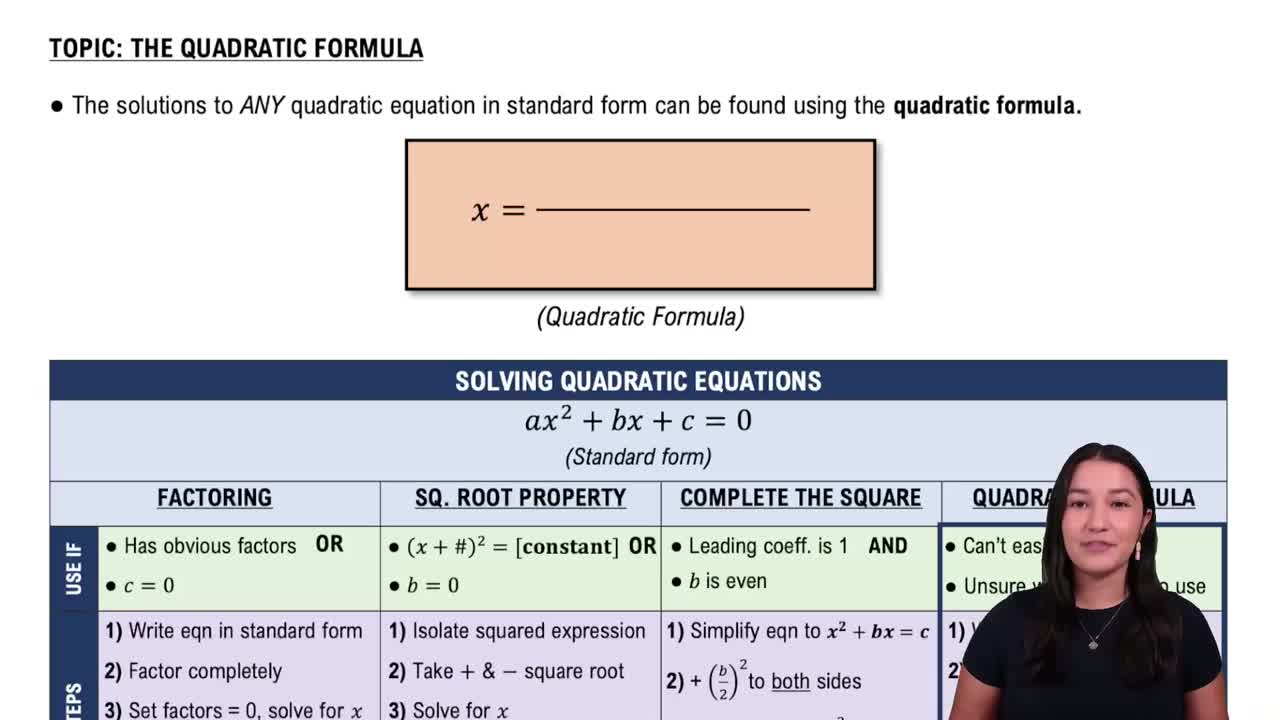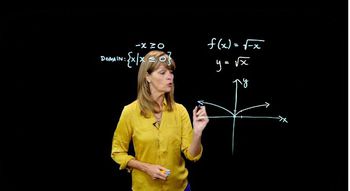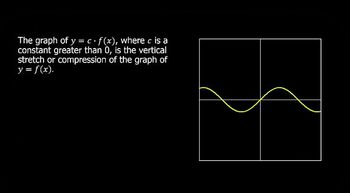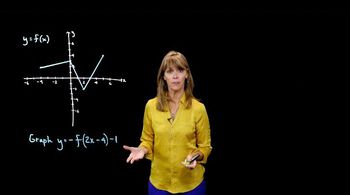Table of contents
- 0. Review of Algebra4h 16m
- 1. Equations & Inequalities3h 18m
- 2. Graphs of Equations43m
- 3. Functions2h 17m
- 4. Polynomial Functions1h 44m
- 5. Rational Functions1h 23m
- 6. Exponential & Logarithmic Functions2h 28m
- 7. Systems of Equations & Matrices4h 6m
- 8. Conic Sections2h 23m
- 9. Sequences, Series, & Induction1h 19m
- 10. Combinatorics & Probability1h 45m
3. Functions
Transformations
Problem 62b
Textbook Question
In Exercises 53-66, begin by graphing the standard quadratic function, f(x) = x². Then use transformations of this graph to graph the given function. g(x) = (1/2)(x − 1)²
 Verified step by step guidance
Verified step by step guidance1
Start by graphing the standard quadratic function \( f(x) = x^2 \). This is a parabola that opens upwards with its vertex at the origin (0,0).
Identify the transformation needed for \( g(x) = \frac{1}{2}(x - 1)^2 \). Notice that the function involves a horizontal shift, a vertical stretch/compression, and a vertical shift.
Recognize the horizontal shift: \( (x - 1)^2 \) indicates a shift to the right by 1 unit. This moves the vertex of the parabola from (0,0) to (1,0).
Identify the vertical compression: The factor \( \frac{1}{2} \) in front of \( (x - 1)^2 \) compresses the parabola vertically by a factor of \( \frac{1}{2} \), making it wider.
Graph the transformed function \( g(x) = \frac{1}{2}(x - 1)^2 \) by applying the horizontal shift and vertical compression to the original parabola \( f(x) = x^2 \). The vertex is now at (1,0), and the parabola is wider than the standard parabola.
 Verified video answer for a similar problem:
Verified video answer for a similar problem:This video solution was recommended by our tutors as helpful for the problem above
Video duration:
1mPlay a video:
Was this helpful?
Key Concepts
Here are the essential concepts you must grasp in order to answer the question correctly.
Quadratic Functions
A quadratic function is a polynomial function of degree two, typically expressed in the form f(x) = ax² + bx + c. The graph of a quadratic function is a parabola, which opens upwards if 'a' is positive and downwards if 'a' is negative. Understanding the basic shape and properties of the standard quadratic function, f(x) = x², is essential for applying transformations to graph other quadratic functions.
Recommended video:

Solving Quadratic Equations Using The Quadratic Formula
Transformations of Functions
Transformations of functions involve shifting, stretching, compressing, or reflecting the graph of a function. For quadratic functions, common transformations include vertical and horizontal shifts, which can be represented by modifying the function's equation. For example, in g(x) = (1/2)(x - 1)², the graph is shifted right by 1 unit and vertically compressed by a factor of 1/2, which alters its appearance while maintaining its parabolic shape.
Recommended video:

Domain & Range of Transformed Functions
Vertex Form of Quadratic Functions
The vertex form of a quadratic function is given by f(x) = a(x - h)² + k, where (h, k) is the vertex of the parabola. This form makes it easier to identify the vertex and understand how transformations affect the graph. In the function g(x) = (1/2)(x - 1)², the vertex is at (1, 0), indicating the point where the parabola reaches its minimum value, which is crucial for accurately graphing the transformed function.
Recommended video:

Vertex Form

 5:25m
5:25mWatch next
Master Intro to Transformations with a bite sized video explanation from Nick Kaneko
Start learningRelated Videos
Related Practice

























